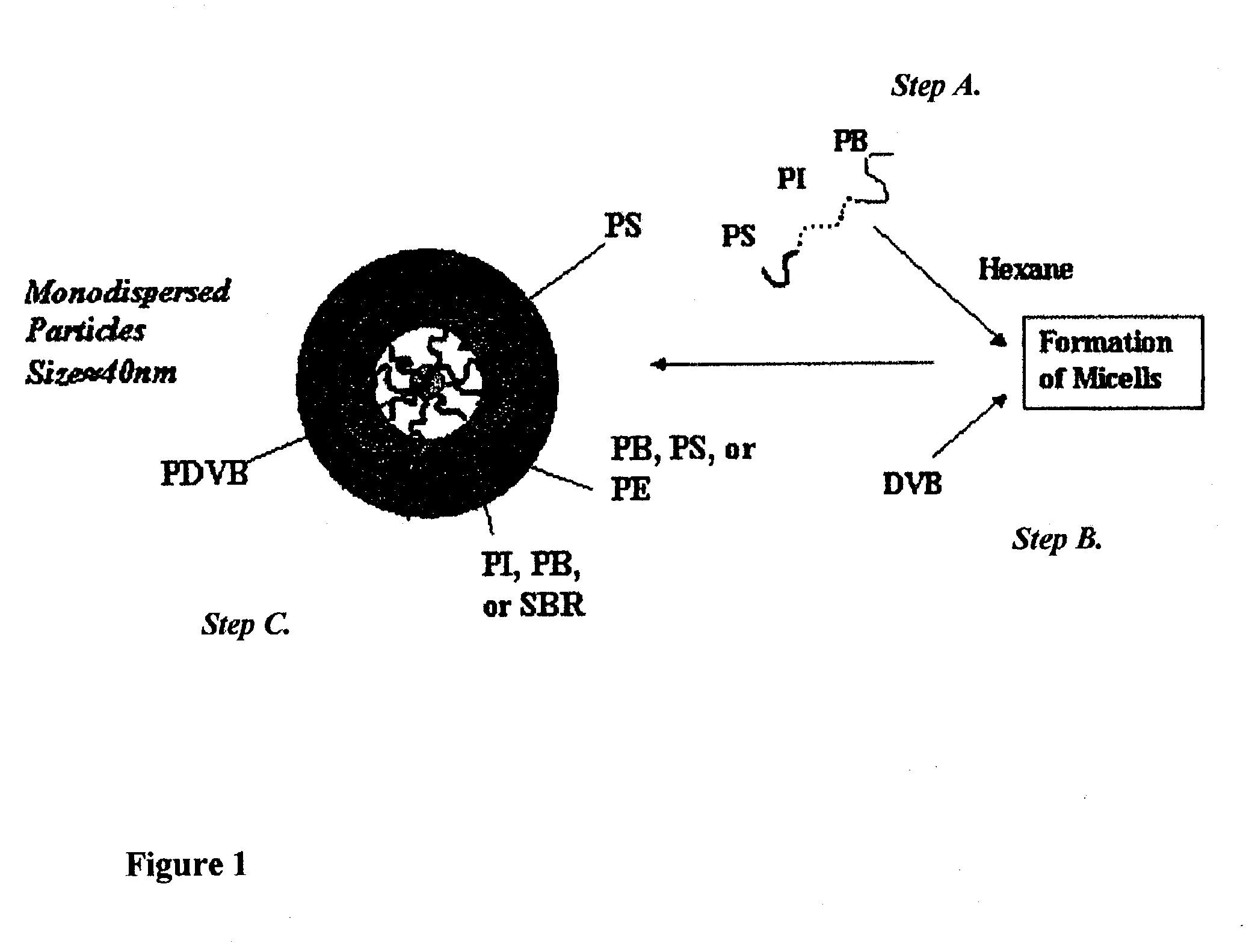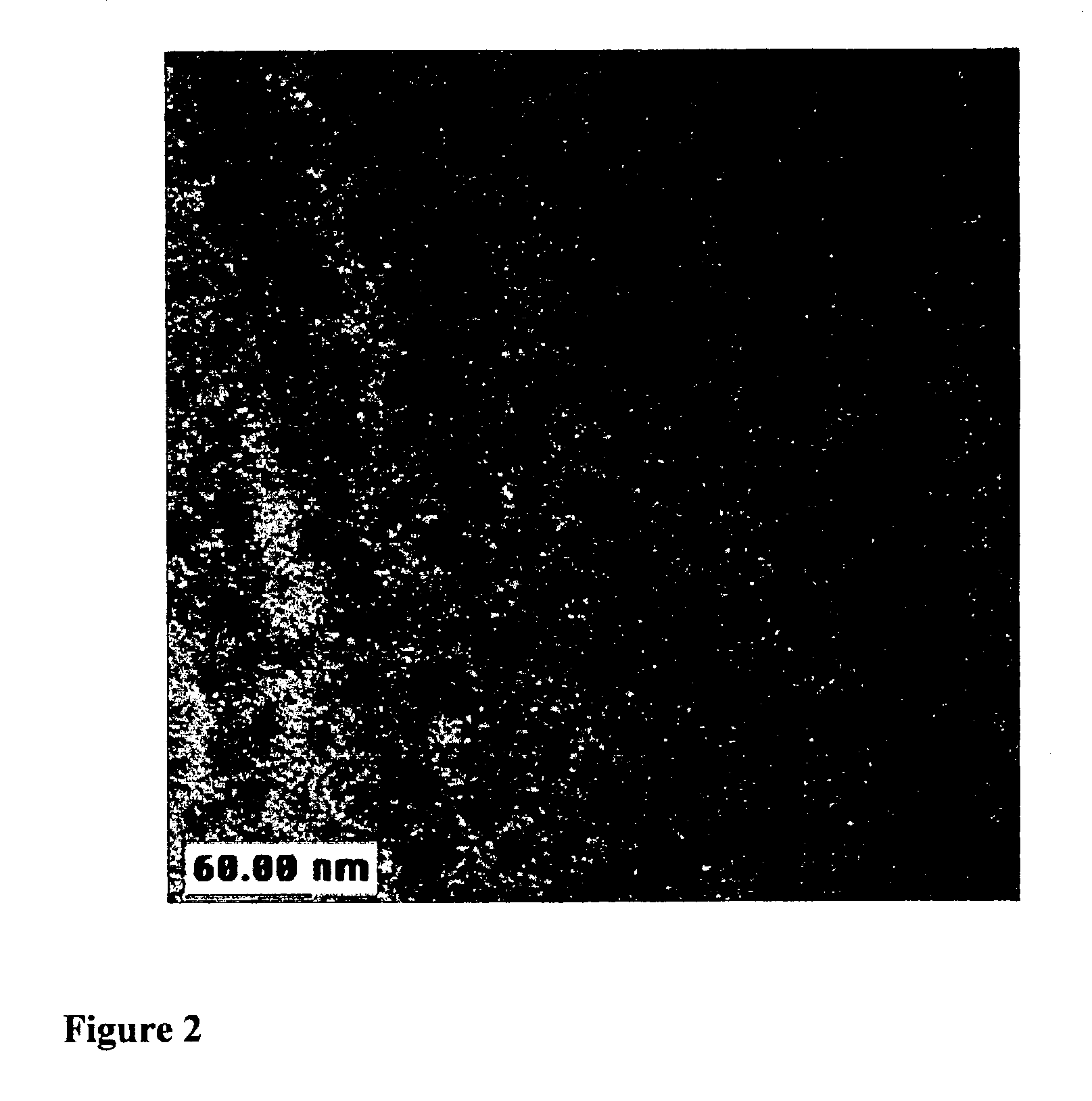Multi-layer nano-particle preparation and applications
a nano-particle and multi-layer technology, applied in the field of polymer nanoparticles, can solve the problems of difficult control of the size of nano-particles during polymerization and/or the surface characteristics of such nano-particles, difficult development of a process capable of reliably producing acceptable nano-particles, and degradation of matrix materials, i.e. rubber, characteristics, etc., to achieve low shrinkage properties, good tensile strength, and high hyster
- Summary
- Abstract
- Description
- Claims
- Application Information
AI Technical Summary
Benefits of technology
Problems solved by technology
Method used
Image
Examples
example 1
The reactor was first charged with 2.3 kg of hexane. The reactor was then charged with 517 g butadiene / hexane blend that contained 22 wt % butadiene, and the batch was heated to 57° C. After the temperature stabilized, polymerization was initiated with 5.4 mL of a 1.5 M solution of n-butyl lithium in hexane. The reactor batch temperature was maintained at 57° C. for the duration of the polymerization. After 2 hours, (when the reaction was finished) the reactor was charged with 4.5 kg of isoprene / hexane blend that contained 15% isoprene. After 1.5 hours, the reactor was charged with 453 g of a styrene / hexane blend that contained 33 wt % styrene. After an additional 1.5 hours, the reactor was charged with 50 mL of divinyl benzene. The reactor was maintained at 57° C. for a 2-hour period and then discharged. The product was dropped into an acetone / isopropanol (˜95 / 5) blend, and dried. GPC analysis of the product showed that the molecular weight (Mw) of the particle polymer is 954,390. ...
example 2
A 4 L polymerization reactor was used for the preparation. The reactor was first charged with 3 L of a nano-particle / hexane solution, containing 10 wt % of example 1. The reactor was then charged with 75 mL of a Ni catalyst solution, which was made according to the following procedure.
111 mL of nickel octolate (8 wt % in hexane), 37 mL hexane, and 06 mL of cyclohexene were charged to a 1 liter N2 purged bottle. Then, the bottle was placed into a dry ice bath. A charge of 266.4 mL of tributyl aluminum (0.68 M in hexane) was slowly added into the bottle while kept cool.
The hydrogenation reactor, containing polymer product and catalyst was then heated to 120° C. After the temperature stabilized, the hydrogenation was initialized by charging high pressure H2 gas into the reactor to about 792 kPa. After about 15 minutes, the pressure dropped as the H2 began to react. The reactor was again recharged to about 792 kPa. The procedure was then repeated until the butadiene hydrogenation conver...
example 3
The reactor was first charged with 517 g of hexane. The reactor was charged with 340 g styrene / hexane blend containing 33 wt % styrene, and the batch was heated to 57° C. After the temperature had stabilized, polymerization was initiated with 5.4 mL of a 1.5 M solution of n-butyllithium in hexane. The reactor batch temperature was maintained at 57° C. for the duration of the polymerization. After 1.5 hours, (when the reaction was finished), the reactor was charged with 1.0 kg of butadiene / hexane blend that contained 22 wt % butadiene. After another 1.5 hours, the reactor was charged with 340 g of styrene / hexane blend that contained 33 wt % styrene. After an additional 1.5 hour reaction, the reactor was charged with 1.8 kg hexane. After 20 minutes, the reactor was charged with 50 mL of DVB for the crosslinking reaction. The reactor was maintained at 57° C. for another 1.5 hour period, then discharged. The product was dropped into acetone / isopropanol (˜95 / 5) blend, and dried. GPC anal...
PUM
| Property | Measurement | Unit |
|---|---|---|
| Fraction | aaaaa | aaaaa |
| Diameter | aaaaa | aaaaa |
| Temperature | aaaaa | aaaaa |
Abstract
Description
Claims
Application Information
 Login to View More
Login to View More - R&D
- Intellectual Property
- Life Sciences
- Materials
- Tech Scout
- Unparalleled Data Quality
- Higher Quality Content
- 60% Fewer Hallucinations
Browse by: Latest US Patents, China's latest patents, Technical Efficacy Thesaurus, Application Domain, Technology Topic, Popular Technical Reports.
© 2025 PatSnap. All rights reserved.Legal|Privacy policy|Modern Slavery Act Transparency Statement|Sitemap|About US| Contact US: help@patsnap.com



